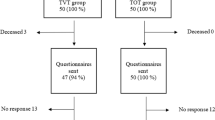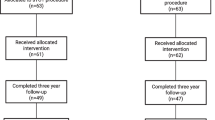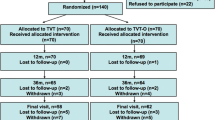Abstract
Purpose
To report the extended long-term results of the use of tension-free vaginal tape(TVT) and trans-obturator tape (TOT) for the treatment of female stress urinary incontinence (SUI).
Methods
A prospective, multicentre randomized clinical trial comparing the use of TVT and TOT was used to evaluate 87 patients. The inclusion criteria were stress or mixed UI associated with urethral hyper mobility (the stress component was clinically predominant), while the exclusion criteria were previous anti-incontinence surgery and/or pelvic organ prolapse. The objective cure criteria were a negative provocative stress test and a negative 1-h pad test, with no further treatment for SUI. The subjective cure criteria were a 3-day voiding diary, quality-of-life questionnaires (UDI6–IIQ7), and patient satisfaction on a scale from 0 to 10.
Results
Eighty-seven patients were evaluated (47 TOT and 40 TVT) at a median follow-up of 100 months. Subjective and objective cure rates were 59.6 and 70.2 % in the TOT group and 75 and 87.5 % in the TVT group. The mid-to-long-term trend was a decreasing continence rate in patients who underwent TOT, compared with a stable rate for TVT. The Kaplan–Meier survival curve showed that continence rate decreased for up to 25 months after surgery, with stabilization thereafter for the TVT group while continuing to drop in the TOT group, with no inter-group difference.
Conclusion
The patients in both groups were highly satisfied at long-term follow-up. The overall continence rate worsened for both groups within 25 months. While the results tend to stabilize in the TVT group, a further decline in the TOT was observed.





Similar content being viewed by others
References
Serati M, Salvatore S, Uccella S et al (2009) Surgical treatment for female stress urinary incontinence: what is the gold-standard procedure? Int Urogynecol J Pelvic Floor Dysfunct 20:619–621
Oliphant SS, Wang L, Bunker CH, Lowder JL (2009) Trends in stress urinary incontinence inpatient procedures in the United States, 1979–2004. Am J Obstet Gynecol 200(5):521.e1–521.e6
Novara G, Ficarra V, Boscolo-Berto R, Secco S, Cavalleri S, Artibani W (2007) Tension free mid-urethral slings in the treatment of female stress urinary incontinence: a systematic review and meta-analysis of randomized controlled trials of effectiveness. Eur Urol 52:663–678
Ogah J, Cody JD, Rogerson L (2009) Minimally invasive synthetic suburethral sling operations for stress urinary incontinence in women. Cochrane Database Syst Rev (4):CD006375. doi:10.1002/14651858.CD006375.pub2
Latthe PM, Foon R, Toozs-Hobson P (2007) Transobturator and retropubic tape procedures in stress urinary incontinence: a systematic review and meta-analysis of effectiveness and complications. BJOG 114:522–531
Novara G, Galfano A, Boscolo-Berto R et al (2008) Complication rates of tension-free mid-urethral slings in the treatment of female stress urinary incontinence: a systematic review and meta-analysis of randomized controlled trials comparing tension-free midurethral tapes to other surgical procedures and different devices. Eur Urol 53:288–308
Porena M, Costantini E, Frea B, Giannantoni A, Ranzoni S, Mearini L, Bini V, Kocjancic E (2007) Tension-free vaginal tape versus Transobturator tape as surgery for stress urinary incontinence: results of a multicentre randomised trial. Eur Urol 52:1481–1491
Costantini E, Lazzeri M, Zucchi A, Di Biase M, Porena M (2014). Long-term efficacy of the transobturator and retropubic mid-urethral slings for stress urinary incontinence: single-center update from a randomized controlled trial. Eur Urol 66(3):599–601
Bump RC, Mattiasson A, Bo K et al (1996) The standardization of terminology of female pelvic organ prolapse and pelvic floor dysfunction. Am J Obstet Gynecol 175:10–17
De Lorme E (2001) Transobturator urethral suspension: mini-invasive procedure in the treatment of stress urinary incontinence in women. Prog Urol 11:1306–1313
Serati M, Ghezzi F, Cattoni E, Braga A et al (2012) Tension-free vaginal tape for the treatment of urodynamic stress incontinence: efficacy and adverse effects at 10-year follow-up. Eur Urol 61:939–946
Albo ME, Litman HJ, Richter HE et al (2012) Urinary incontinence reatment network. Treatment network treatment success of retropubic and transobturator mid urethral slings at 24 months. J Urol 188:2281–2287
Schierlitz L, Dwyer PL, Rosamilia A et al (2012) Three-year follow-up of tension-free vaginal tape compared with transobturator tape in women with stress urinary incontinence and intrinsic sphincter deficiency. Obstet Gynecol 119(2, Part 1):321–327
Costantini E, Lazzeri M, Giannantoni A et al (2008) Preoperative Valsalva leak point pressure may not predict outcome of mid-urethral slings. Analysis from a randomized controlled trial of retropubic versus transobturator mid-urethral slings. Int Braz J Urol 34(1):73–83
Nager CW, Sirls L, Litman HJ et al (2011) Urinary incontinence treatment network. baseline urodynamic predictors of treatment failure 1 year after mid urethral sling surgery. J Urol 186:597–603
De Lancey JO (1994) Structural support of the urethra as it relates to stress urinary incontinence: the hammock hypothesis. Am J Obstet Gynecol 170:1713–1720
Whiteside JL, Walters MD (2004) Anatomy of the obturator region: relations to a trans-obturator sling. Int Urogynecol J Pelvic Floor Dysfunct 15:223–226
Serati M, Bauer R, Cornu JN, Cattoni E et al (2013) TVT-O for the treatment of pure urodynamic stress incontinence: efficacy, adverse effects, and prognostic factors at 5-year follow-up. Eur Urol 63:872–878
Debodinance P, Delporte P, Engrand JB, Boulogne M (2002) Tension-free vaginal tape (TVT) in the treatment of urinary stress incontinence: 3 years experience involving 256 operations. Eur J Obstet Gynecol Reprod Biol 105:49–58
Ustun Y, Engin-Ustun Y, Gungor M, Tezcan S (2003) Tension-free vaginal tape compared with laparoscopic Burch urethropexy. J Am Assoc Gynecol Laparosc 10:386–389
Ward KL, Hilton P, UK and Ireland TVT Trial Group (2004) A prospective multicenter randomized trial of tension-free vaginal tape and colposuspension for primary urodynamic stress incontinence two-year follow-up. Am J Obstet Gynecol 190:324–331
Costantini E, Lazzeri M (2010) Elephants can remember. Eur Urol 58(5):678–679
Author information
Authors and Affiliations
Corresponding author
Ethics declarations
Conflict of interest
All authors certify that all conflicts of interest, including specific financial interests and relationships and affiliations relevant to the subject matter or materials discussed in the manuscript (e.g. employment/affiliation, grants or funding, consultancies, honoraria, stock ownership or options, expert testimony, royalties, or patents filed, received, or pending), are the following: None.
Authors contributions
Protocol/project development: Costantini, Zucchi, Lazzeri, Giannantoni, and Porena; data collection or management: Costantini, Kocjancic, and Zucchi’ data analysis: pastore, Giannantoni, Carbone, Bini, and Palleschi; manuscript writing/editing: Costantini, Kocjancic, Lazzeri, Giannantoni, Zucchi, Carbone, Bini, Palleschi, Pastore, and Porena.
Rights and permissions
About this article
Cite this article
Costantini, E., Kocjancic, E., Lazzeri, M. et al. Long-term efficacy of the trans-obturator and retropubic mid-urethral slings for stress urinary incontinence: update from a randomized clinical trial. World J Urol 34, 585–593 (2016). https://doi.org/10.1007/s00345-015-1651-z
Received:
Accepted:
Published:
Issue Date:
DOI: https://doi.org/10.1007/s00345-015-1651-z




